Loading...
Products
Magic: The Gathering Line
The past couple of months have been a great time to be a Standard fan. After the printing of Foundations, the metagame has kept evolving rapidly and provided plenty of opportunities to innovate and find an edge over the competition. Arena Championship 7 and the Spotlight Series in Atlanta have incentivized players to work hard on the format, in addition to the usual tournaments like Magic Online Qualifiers.
Speaking of the online tournaments, I managed to win a 117 player Standard Qualifier tournament on Magic Online, and I felt like a big reason for that success was choosing the right deck for the weekend.
A lot has happened, so what should you be aware of before heading into Aetherdrift? How did I find a hole in the metagame to win the Qualifier? What will be the cornerstones of Standard for the near future and why? Keep reading to find out!
Ever since the introduction of Foundations, the two decks at the center of the stage have been Dimir Midrange and Gruul Aggro, both being clearly more popular than the rest of the metagame. Both decks have a lot of raw power and they attack the format from different angles. This forms a sort of bind that is typical for metagames: the harder you try to beat one of them, the more you lose to the other one. Since there’s not much overlap in the interaction and strategies that are effective against both decks, their combination tends to push out a lot of other decks from the metagame.
As a practical example, Anoint with Affliction is a nice removal spell against Gruul, as it cleanly answers a pumped up Heartfire Hero. However, it doesn’t help at all against either of the heavy hitters from Dimir Midrange: Enduring Curiosity and Kaito, Bane of Nightmares. On the other hand, a deck like Mono-White Control has to resort to cards like Get Lost to be able to deal with Kaito, Bane of Nightmares, but the Map tokens often make it an embarrassingly awkward card against the Gruul Aggro deck that specifically gets benefits from repeatedly targeting its own creatures.
Therefore, it’s not exactly surprising that these two decks faced off against each other in the finals of the Arena Championship 7. Here’s the deck that Keisuke Sato used to win the tournament:
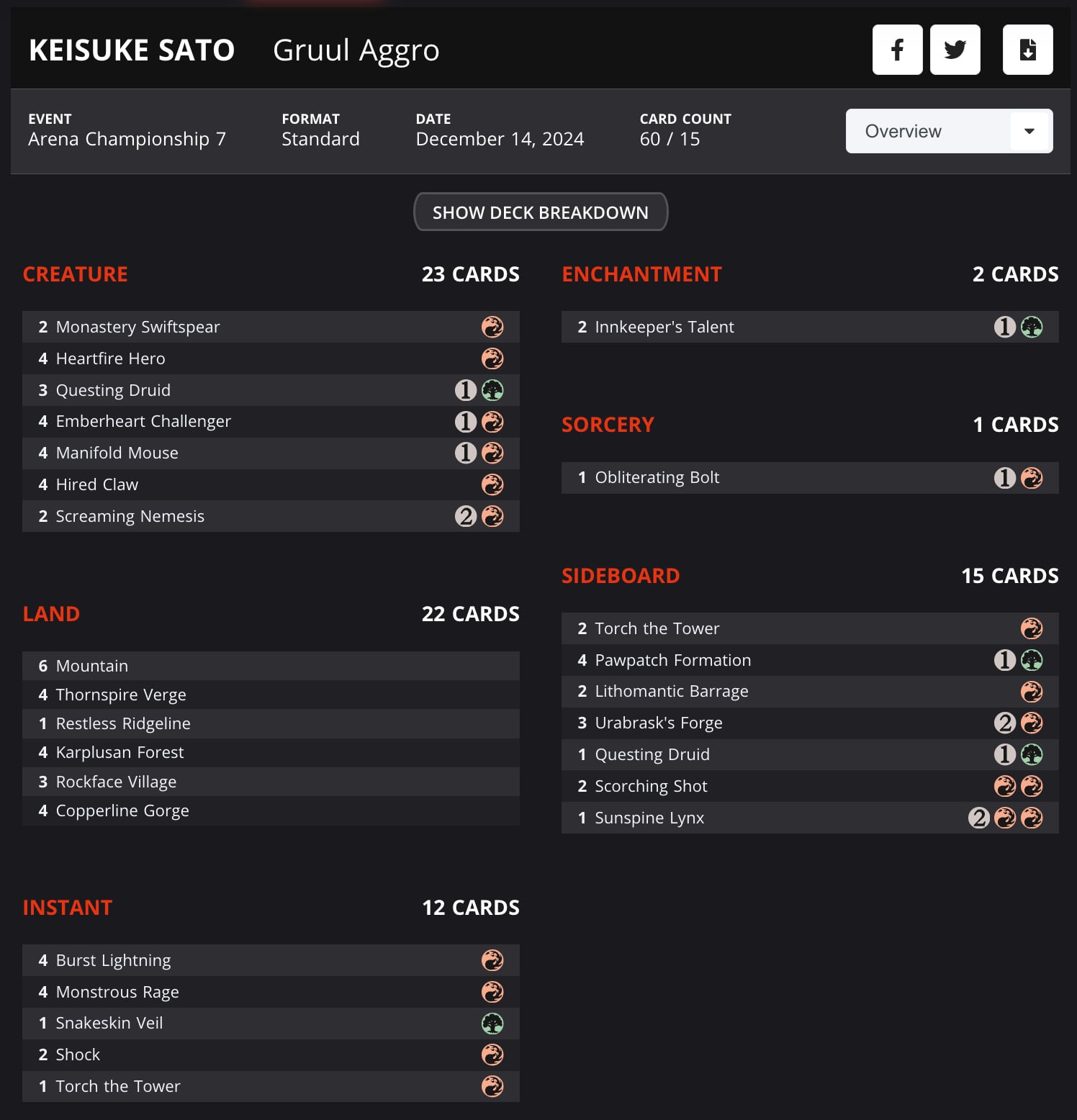
And here’s the version of Dimir Midrange that my good friend Mikko Airaksinen used to get 2nd place:
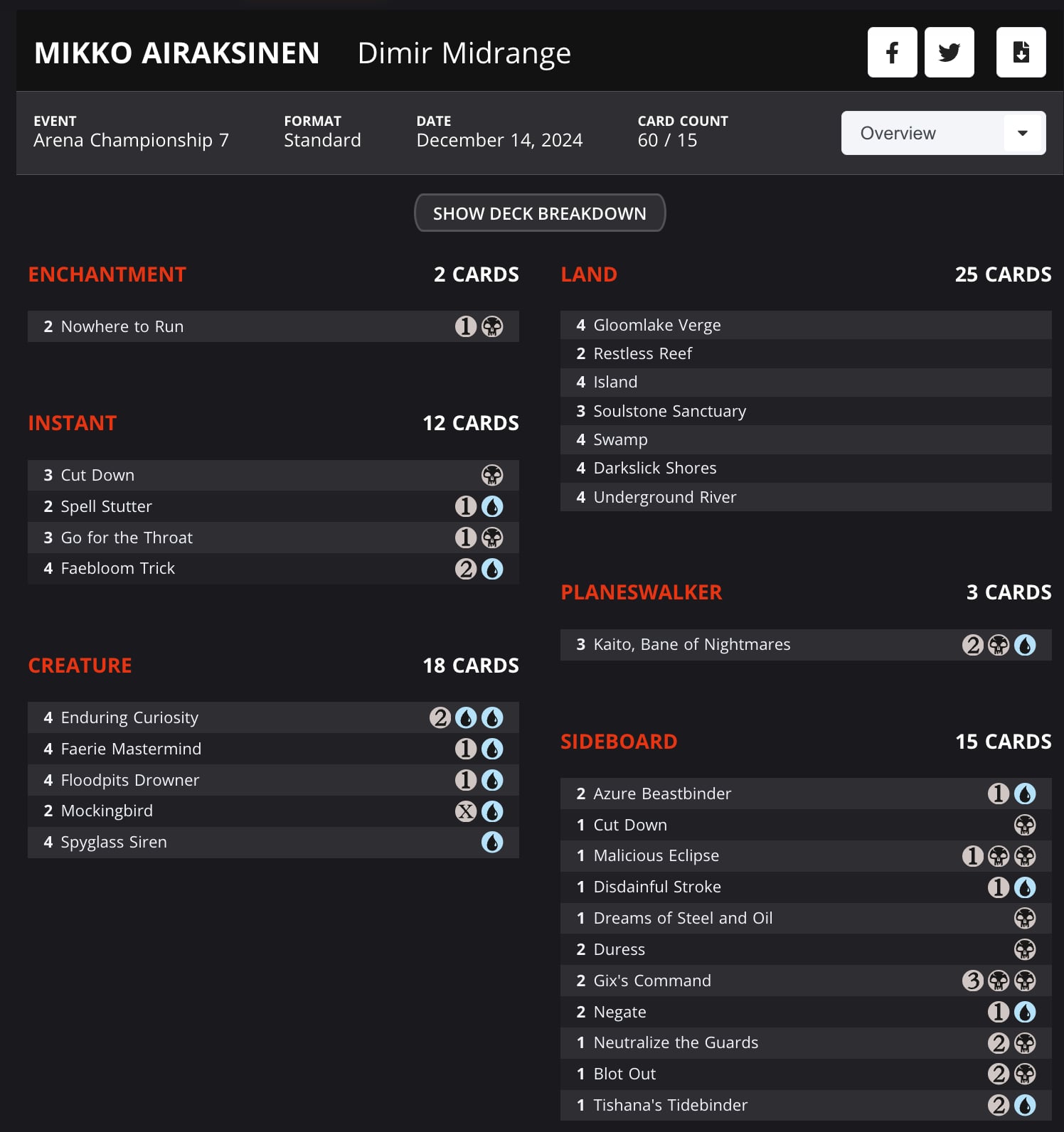
Of particular note in Mikko’s deck are the 4 copies of Faebloom Trick. Those gave him a huge advantage against the other Dimir Midrange players, and on his way to the finals Mikko easily beat every single mirror match that he played.
The Faebloom Tricks also work extremely well with Enduring Curiosity, to the extent that Mikko compared the combination of these cards to be similar to turn 3 Deceiver Exarch into turn 4 Splinter Twin. Both halves of the “combo” are also resilient to many forms of interaction, which makes it really effective against any slower, reactive deck. The downside, of course, is that the Tricks can be a bit underwhelming against Gruul Aggro.
The next development that happened was the rise of Esper Pixie, which started out as a fringe deck on Magic Online but quickly became more and more popular as players started realizing it was an actual strong deck and not just a janky meme deck.
Here’s the list that MTGO grinder claudioh used to win a Magic Online Challenge at the beginning of the year:
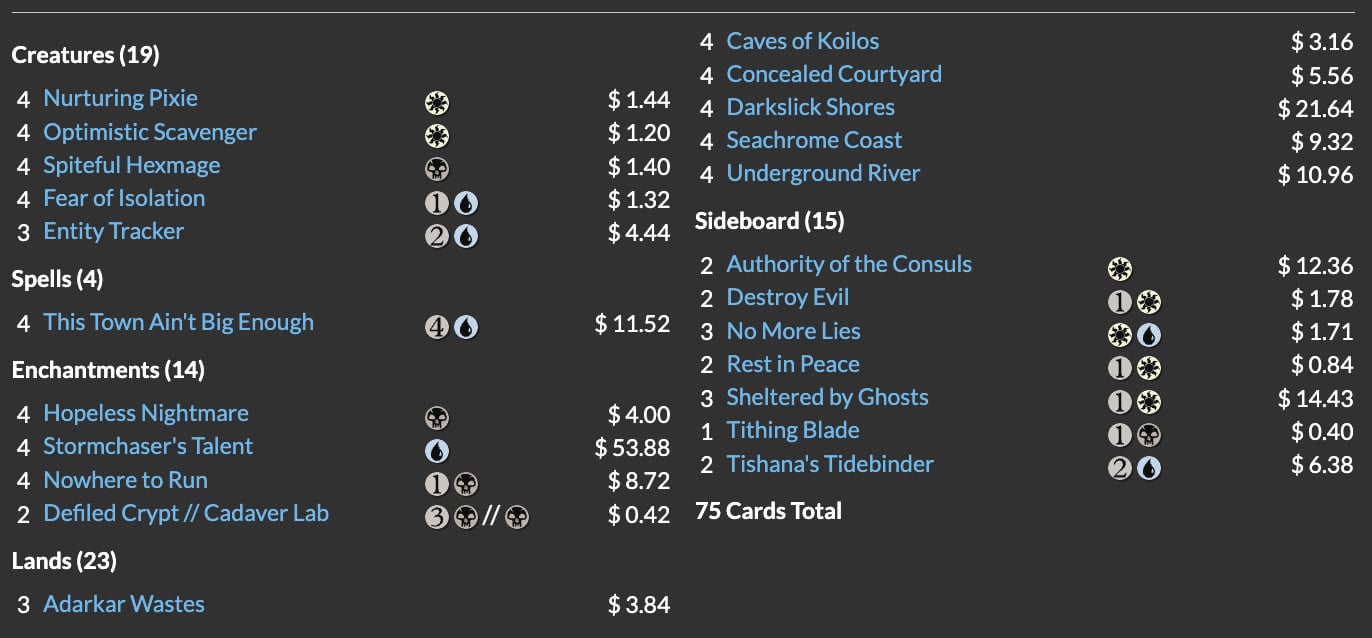
The combination of This Town Ain’t Big Enough and Stormchaser’s Talent had already proven powerful in other decks like Simic Tempo and Temur Otters, and the Esper deck is built to expand on the theme of rebuying enters the battlefield effects with both more ways to bounce the enchantments (Nurturing Pixie, Fear of Isolation) and more enchantments with powerful triggers to reuse (Hopeless Nightmare, Nowhere to Run).
One of the things I like the most about the Talent + This Town synergy is that it’s good in both fast games and slow games. The prowess Otter is a credible threat on turn 1 and This Town Ain’t Big Enough is a good tempo play in the early midgame, and draws containing multiple copies of the Talent can get out of hand very quickly. What really sets it apart from other 1 drops though, is that it’s also going to be one of your best draws in the late game! Looping these two cards together provides an infinite stream of value that is only capped by the amount of mana that you have at your disposal, making it a powerful engine for the late game.
The Pixie deck is very resilient and full of card advantage. Hopeless Nightmare in particular becomes very powerful when triggered repeatedly, as both the damage and the discard effects stack up quickly. Discarding one card usually isn’t too bad for opponents, but when you find yourself empty-handed and low on life after the third trigger, you really start appreciating its power.
Most importantly, I think this deck was a way to beat up on both Dimir and Gruul! It has some issues in other matchups, but being favored against the two most popular decks in the format is always a good place to start from.
While the Spotlight series tournament was eventually won by a Gruul deck, Scott McNamara finished in second place by creating a hybrid between the Pixie deck and the Dimir Midrange deck:
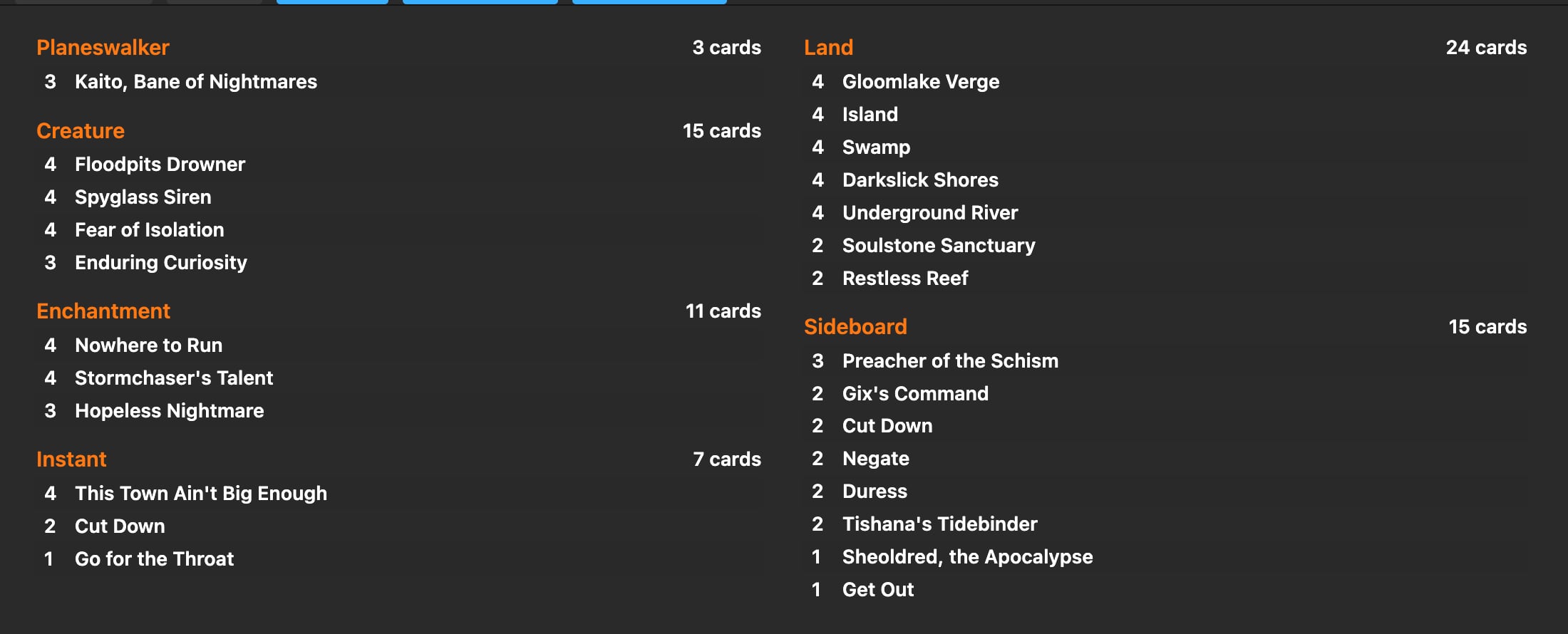
By sticking to only two colors, the mana base improves a lot, and by not going all-in on the synergies the deck becomes more versatile and resilient, albeit less powerful in the abstract.
Going into the Spotlight Series tournament in Atlanta, the Pixie deck had become a real player in the metagame, and competitors were actively looking for ways to beat it. Many of them came prepared with Obstinate Baloths and Wilt-Leaf Lieges to turn the Hopeless Nightmare triggers into a liability.
While effective against the discard enchantment specifically, these cards have the issue of being feeble in its absence. This problem is exacerbated by the fact that the timing window on these cards is rather narrow - not only does the opponent not always have the Hopeless Nightmare in the first place, but sometimes you draw the Baloth or the Liege after they’ve already cast their Nightmares, and other times you have had to cast your cards first and then they play their Nightmares afterwards. In each of these cases, the Baloth and the Liege can be cumbersome. In addition, if the Baloth comes down from a slower deck like Domain, sometimes it can just be ignored completely or stunned into oblivion by Kaito, Bane of Nightmares.
However, I found a different way to attack the popular Pixie deck from a similar angle, but with less downsides. This is the deck I used to take down the Standard Qualifier on the same weekend as Atlanta:
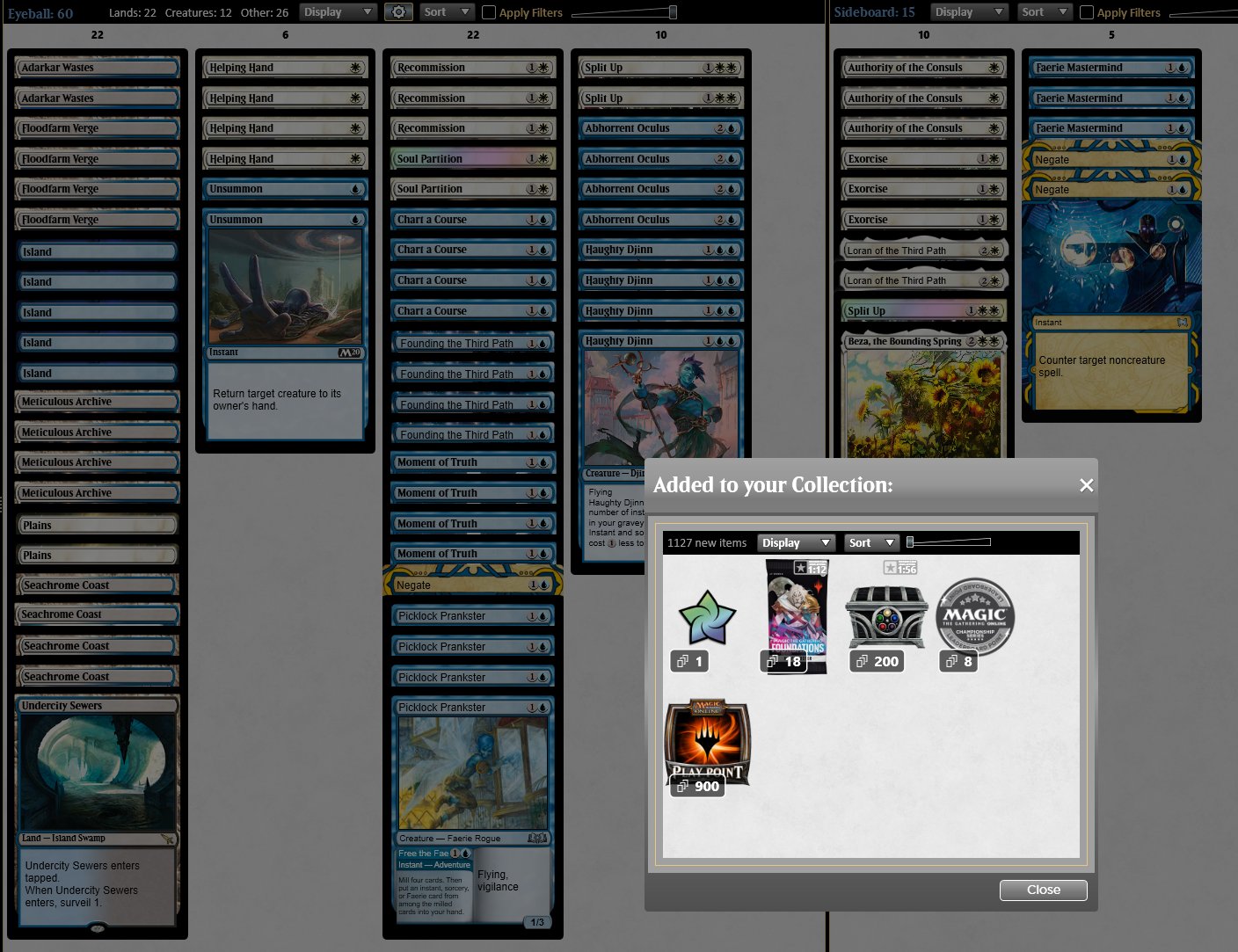
The Oculus deck has a couple of features that make it naturally well set up for the Pixie matchup. The first and most obvious one is that the deck is already voluntarily looking to discard cards! A turn 1 Hopeless Nightmare becomes quite embarrassing when you discard an Abhorrent Oculus to it and then animate the Oculus with a Helping Hands. In many spots discarding an Oculus or a Djinn is something that you get to do, not something you have to do. An early Oculus in particular can quickly run away with the game, and the Pixie deck has very few ways to get rid of it. Even if they can kill it or bounce it, it’s likely to come back soon, and you might have already manifested another banger into play from the upkeep triggers too.
Poor alignment of the interaction suite from the Pixie deck is the other big reason why the matchup is appealing for Oculus. The Esper deck relies heavily on Nowhere to Run for dealing with creatures, but all of the Oculus deck’s threats are conveniently resistant to the -3/-3 effect. Thus, the Oculus deck is structurally very favored in the matchup.
Rest in Peace can be a problem in the post-board games, of course, but I have found it to be less effective from the Pixie deck than from other decks. A part of this is because you can somewhat freely bring in ways to kill the potential Rest in Peace without having to fear them being dead draws, as they have plenty of other targets for disenchant effects.
Speaking of Rest in Peace, another major reason why I chose to play the Oculus deck was that I noticed a lot of lists skimping on graveyard hate and wanted to take advantage of that. Unsurprisingly, graveyard decks are pretty good when there’s not much graveyard hate going around.
After the Spotlight series, the metagame has continued adapting. One of the most significant patterns is players moving away from creatures with 3 toughness or less in order to insulate themselves from Nowhere to Run. A good example of this is the type of Golgari Midrange deck that is being championed by Magic Online user VitorCarvalho01:
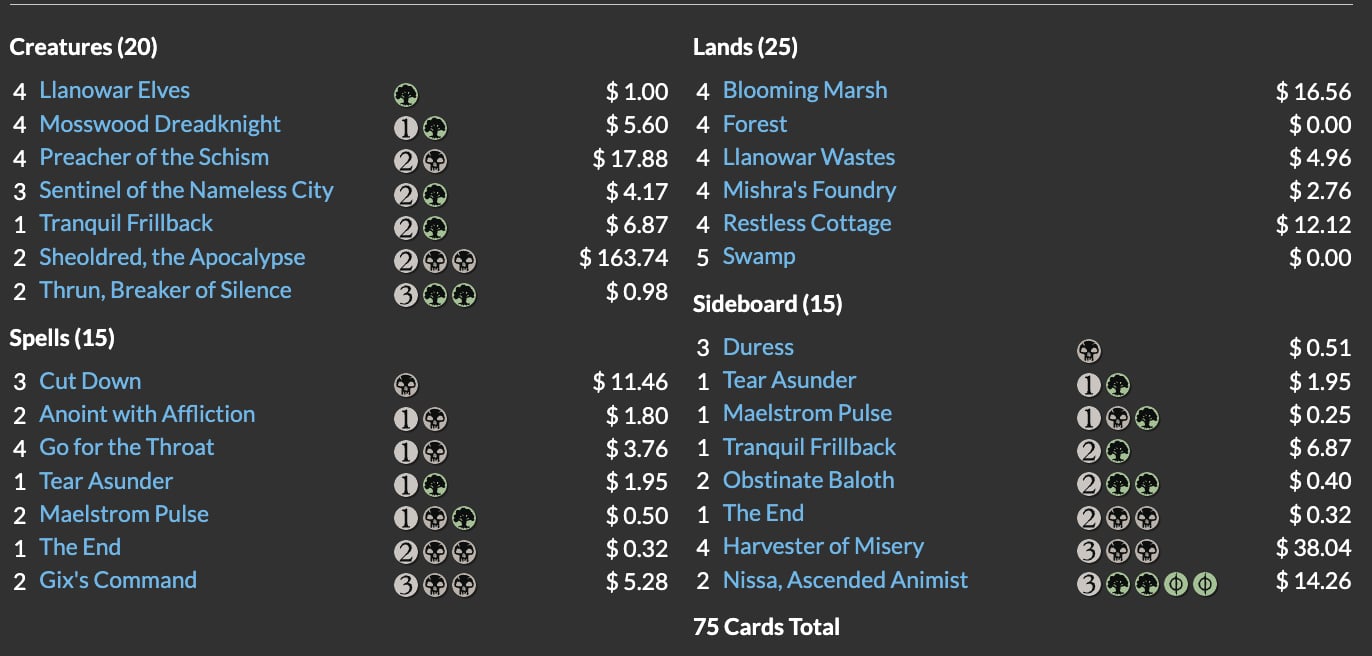
In the past the Golgari decks have played multiple copies of Glissa Sunslayer, as it is perhaps the most powerful of the 3 drop options in a vacuum. However, due to its weakness against the enchantment decks, players now gravitate more towards Preacher of the Schism and Sentinel of the Nameless City to get the same kind of structural edge as the Oculus deck does naturally. Another sign of respect towards the enchantment decks are the two copies of Thrun, Breaker of Silence, which are very hard for the Dimir and Esper decks to deal with.
As you can see, the metagame has never stopped evolving after the printing of Foundations, and it feels like there would still be room to explore new things even if there wasn’t a new set coming out!
While Aetherdrift will undoubtedly introduce even more possibilities to the format, hopefully this article has given you a good understanding of what the metagame looks right now and why. After all, even if the new set shakes things up a bit, the new metagame will be built on top of the existing one. One might even say that the current metagame acts as the Foundations for the upcoming one…